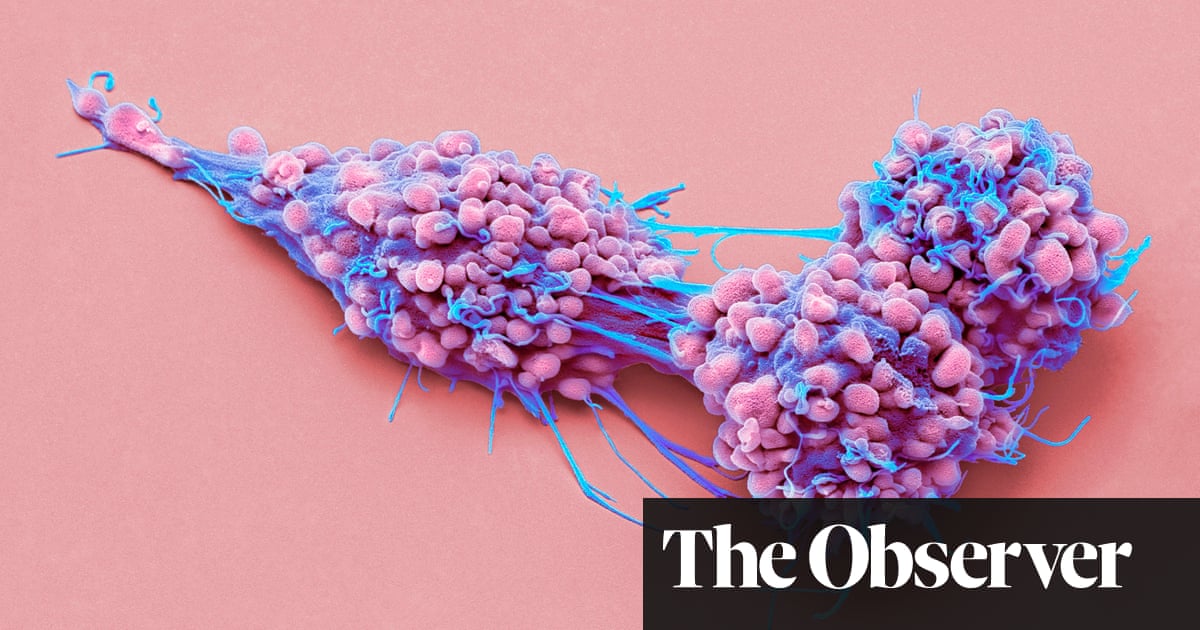
n May, PhD students who are funded by the Medical Research Council (MRC) were invited to enter the Max Perutz science writing award 2020 and to tell the general public “why your research matters”. From the many entries received, the 10 that made the shortlist covered diverse topics, including motor neurone disease, self-harm, babies’ experiences of pain, and bone loss resulting from space travel.
The essays were judged by the Observer’s Ian Tucker, the Science Museum’s Roger Highfield, Prof Fiona Watt from the MRC, Bristol University’s Andy Ridgeway and the journalist and broadcaster Samira Ahmed.
At a virtual ceremony last Tuesday, the £1,500 prize was presented to the winner, Sarah Taylor from the MRC Institute of Genetics and Molecular Medicine at the University of Edinburgh for her article about her research into the influence of proteins on the effectiveness of chemotherapy.
Here we publish the winning article, described by Samira Ahmed as a “terrifically told and intriguing story”.
She sits in the small consulting room once again, waiting to hear the news of her latest scan. It has been a difficult journey since the last time she sat in this chair, before her most recent round of treatment began. Over a month of exhaustion, vomiting, soreness, sleepless nights and the inevitable hair loss. But this time, the chemotherapy has not been successful. After all the side effects, all the pain that she has endured, her tumour is still growing, a dark mass on her ovary. Where does she go from here? What can she do when the treatment she’s pinned all her hopes on just stops working?
This situation is all too common for women with high grade serous ovarian cancer (HGSOC), a devastating form of ovarian cancer. Only 35% survive longer than five years following their diagnosis. While chemotherapy and surgery are highly effective at initially shrinking tumours, the cancer continues to fight back. Over time the tumour changes, with cells that survive treatment prevailing and replicating, passing on the protective traits that give them that survival edge. The tumour becomes completely resistant to chemotherapy, and no barrier remains to stop it from growing out of control and overwhelming the body.
However, there are groups of patients whose cancers are much more sensitive to chemotherapy treatment than others, who can be completely cured by chemotherapy. One key to this is DNA repair proteins, the tools that all cells use to protect their DNA from damage. Think of this DNA as the instruction manual for a cell, detailing how to build all the proteins the cell requires to live and carry out different functions. Cancer cells often have defective DNA repair proteins, as this allows them to adapt and grow rapidly. Strange as it may sound, this can be a good thing from our perspective! Chemotherapy kills cancer cells by attacking their DNA, and those which lack DNA repair proteins essentially forgot to bring a first aid kit – they cannot fix themselves up and keep going. This means that the chemotherapy can completely kill off the cancer, so the patient will survive. This reveals gaps in the armour of this cancer, which we can exploit to help the women who need it most.
No two cancers are quite the same, even within a specific type like HGSOC. Some have completely functional DNA repair proteins. Some have defective proteins initially but can adapt and fix these. Others can make excessive amounts of the proteins to combat the effects of chemotherapy and survive. I hope that by learning what happens to these proteins as a cancer cell becomes resistant to chemotherapy, I can make new drugs to prevent the crucial DNA repair proteins from functioning, which will enable the chemotherapy to kill cancer cells more effectively.
The first question that I asked was which, if any, of these proteins are actually important for the way HGSOC reacts to chemotherapy. I used cells taken from HGSOC patient tumours and adapted to grow easily in the lab, called cell lines, which have similar properties to an actual tumour in a patient. By using cell lines taken from a selection of patient tumours, scientists can build up a picture of the similarities and differences between patient tumours. I started by assessing the growth of various cell lines when treated with a drug called carboplatin, the standard chemotherapy used to treat HGSOC. The slower the cells grow, the more effective it is as a treatment. I found that there was a lot of variation in sensitivity to carboplatin between the different cell lines – unsurprising really since one of the main challenges in cancer research is how many differences there are between individual’s tumours, and even between different parts of the same tumour.
Next, I set out to find the reason for these differences, looking for changes in the DNA repair proteins. I studied a database of ovarian cancer patients looking for clues on what could be going on, and found that it is common for the tumour cells to produce either abnormally high or low amounts of certain DNA repair proteins. So, I decided to measure the amount of repair proteins produced by my cell lines. I found that in the cell line that was most sensitive to chemotherapy, one of these repair proteins was almost entirely missing! This is a really good indicator that this protein could be an important factor behind repairing the damage caused by chemotherapy.
So, I had identified a protein potentially involved in chemotherapy effectiveness. What next? I wanted to confirm that this protein acts in the way I suspected within the cancer cells. I blocked the cell lines from producing the protein I was interested in, and again looked to see how sensitive to chemotherapy the cancer cells were. This confirmed my initial suspicions – removing the protein made the cancer cells much more susceptible to chemotherapy!
As I am only in my first year of working on this project, there is still much to be done, but this is an exciting starting point. I certainly find it very exciting! I plan to study the mechanism used by these cancer cells to alter the amount of this repair protein, and see how smart the cancer cells are – are they cheating the chemotherapy by producing more of this protein to prevent the cells from being killed? Does this result in a chemotherapy-resistant tumour? Most importantly, I would like to identify patients whose cancers have high levels of this repair protein, for whom conventional chemotherapy might be less effective, and focus on how I can help them. To tackle this problem, I would like to test drugs that block this protein from carrying out DNA damage repair, leaving the cancer powerless, unable to repair the damage inflicted by chemotherapy. My dream is that one day this will help more women to leave that consulting room feeling victorious, having beaten the odds, and able to shut the door for good on their way out.












